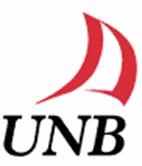
Tommi Linnansaari, Ph.D.
Research AssociateM.Sc. (University of Helsinki), Ph.D. (University of New Brunswick)
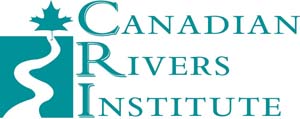

|
Tommi Linnansaari, Ph.D.
Research AssociateM.Sc. (University of Helsinki), Ph.D. (University of New Brunswick) |

|
| Home page
Personal information Current projects Past projects Publications Teaching experience Evolution of a Ballcap NEWS |
Past projects
Projects I have worked on in the past, or that has been temporarily set aside on a backburner Projects at Canadian Rivers Institute (2009-2012) Review and recommendation on Instream flow assessment methodologies for Canadian Science Advisory Secretariat (CSAS) I was an inivited senior author of a summary and review report of current instream flow needs assessment methodologies. The report served as an input for a CSAS review meeting held in Montreal in March 2012. The Science Advisory Report, where the proceedings of this meeting are listed, is available on the CSAS website. Collaborators: Dr. A. Curry (CRI) , Drs. D. Baird and W. Monk (Environment Canada) Lake sturgeon (Acipenser fulvescens) studies; M.Sc. student supervision I co-supervised a M.Sc. student (Laura Henderson) with Dr. S. Peake. The project focused on a juvenile lake sturgeon population in the hydro-regulated Winnipeg River in Manitoba, downstream from the Slave Falls (SFGS) generating station. Laura successfully defended her thesis in April 2013 and is now in the publishing phase of these findings. I also continue to work with recently graduated students (M.Sc. Claire Hrenchuk and M.Sc. Holly Labadie) in publishing their findings (adult sturgeon). PIT-telemetry and snorkeling comparisons I supervised a B.Sc. Honours thesis student (Theoren Ellis) who worked on a project examining 1: Fright bias of juvenile stream salmonids as a function of water temperature during active PIT-tracking; 2: Similarity of in-stream habitat use data collected using snorkeling vs PIT-methods. The main findings of this research project indicated that juvenile Atlantic salmon tolerate PIT-tracking very well in habitats where they are most often found. However, one-in-four parr was frightened in habitats that offer no cover for them to hide (very shallow, non-turbulent habitats); salmon parr rarely occupy such areas. In winter, no fright bias was introduced in any type of habitat. PIT-tracking also resulted in larger datasets of habitat use when compared to snorkeling. PIT-tracking was particularly useful during low flow periods in summer, when shallow riffle habitats were readily monitored by PIT-methods, but were unavailable for snorkeling. Photonegative behaviour and cryptic colouration of salmon parr affected the snorkeling counts at any given discharge while PIT-methods were unaffected and resulted in accurate habitat data regardless of the conditions. Theoren's thesis has been published in TAFS, (see publications) . Projects at SINTEF Energy Research, Water Resources (2008-2009) I had the opportunity to participate in a variety of projects during my time as a research scientist with SINTEF. I spent the majority of my time working in a HYDBIO UPSCALE project that can be found from the backburner projects below. I also was involved in a study to design a flow regime in a regulated river (details below). In addition to this, I participated in work examining the greenhouse gas emissions from Norwegian hydropower reservoirs. In another project I studied the effects of an accidental closedown of a hydropower plant on juvenile stream salmonid populations in the River Surna (effects of the emergency water releases from adjacent dams). I was also involved in a project compiling a report on variable models that can be used to evaluate the effects of hydropower operations on environment and finally, was involved in grant proposal writing. More details of some of these projects are available on the publications page. Development of an inflow controlled environmental flow regime for a Norwegian river In this project, we were using Building Block Methodology (BBM) to design a flow regime in the Daleelva River which is regulated for hydropower. The idea was to replace the current, stable flow regime with a more natural regime where higher and lower flows follow a pattern that is akin to naturally flowing rivers in the region. Water releases are "earmarked" for biologically, physically or socio-economically important functions that define a healthy river. In addition, we examined how the variable environmental flow regime can be implemented in practice as it pertains to current Norwegian legislation. For results, see publications. Participating institutions: Norwegian University of Science and Technology (Prof. K. Alfredsen, principal investigator), SINTEF Energy Research (Mr. A. Harby), Norwegian Institute of Nature Research (Dr. O. Ugedal), Canadian Rivers Institute (Dr. T. Linnansaari) The project was funded by Norwegian Water Resources and Energy Directorate (NVE) through the Environmental Flows Programme. Effects of ice conditions on behaviour and population dynamics of Atlantic salmon parr (2003 - 2007) In my Ph.D. project at the University of New Brunswick (UNB), I was stydying how different ice conditions affect juvenile A. salmon. Winter period has traditionally been considered to be a critical period for the survival of juvenile A. salmon. It has not been clear how the ice per se would affect the various aspects of early life of salmon. Climate change will drastically affect the ice conditions in future, and it is important to know what the response of juvenile A. salmon may be to this future change. The work was carried out in NB, Canada and in central Norway. The study sites included streams in their natural state, a river regulated for hydropower production and some experiments in semi-natural channels. Fish movement and behaviour was monitored with a variety of PIT-tools. The results of this work are reported in my Ph.D. thesis which can be found from the publications page. The project was a collaboration between UNB, SINTEF Energy Research, and the Norwegian University of Science and Technology. The project was funded by Norwegian Research Council (grant 147031/720) and Canada Research Chairs Program for Dr. Cunjak. I was supported by personal scholarships from Helsingin Sanomat Centennial Foundation (2004 and 2005), Finnish Cultural Foundation (2005), Emil Aaltonen Foundation (2006), Ethel E.E. Remes Foundation (2006). I also was the recipient of the Jack T. H. Fenety conservation scholarship from Miramichi Salmon Association (2007) and the John S. Little Fellowship (2007). Juvenile Atlantic salmon in deep habitats in large rivers (2002) The objective of this study was to examine whether juvenile Atlantic salmon use "deep" habitats in large rivers. Large number of habitat preference studies for juvenile Atlantic salmon suggest that shallow microhabitats (i.e. < 1 m deep) are better suited for them, however, the data is generally biased towards small streams (and thus, relatively shallow microhabitats) due to logistical difficulties to sample in large, and deep, rivers. In many large rivers, however, the majority of the available area is deeper than 1 m. For management purposes, it was important to know the extent the deep areas are used by juvenile Atlantic salmon. The study was carried out using direct SCUBA diving observations in the River Muonionjoki, in the border of Finland and Sweden, as part of my M.Sc. research. For results, see my publications. The study was a collaboration between University of Helsinki and Finnish Game and Fisheries Research Institute (FGFRI). The study was funded by FGFRI and I was further supported with a research grant by Societas pro Fauna & Flora Fennica. Anadromous brown trout smolt studies in the River Pakajoki, Finland (2002) I was working in this study for my good colleague Mr. S. Vatanen, who was doing his M.Sc. on this topic (currently the CEO of the Fish and Water Research Ltd). The objectives were to understand the migration timing, behaviour and amounts of wild and stocked anadromous brown trout smolts in the River Pakajoki (part of the River Tornionjoki system in the border of Finland and Sweden). Also, the study was examining the optimal timing for brown trout smolt stocking in order to produce fish that migrate to sea instead of becoming resident trout. The study involved fish tagging and stocking, radiotracking, installation and maintenance of the first ever rotatory screw trap operated in Finland. The study was a collaboration between University of Helsinki and Finnish Game and Fisheries Research Institute (FGFRI). The work is currently reported (in Finnish) in the M.Sc. thesis by S. Vatanen. Monitoring of Atlantic salmon and anadromous brown trout stocks in the River Tornionjoki system, Finland (in 1999 and 2001) I worked two summers as a fisheries research technician for the Finnish Game and Fisheries Research Institute monitoring the juvenile salmonid stock in the River Tornionjoki. This work included daily monitoring of a very large fyke net, tagging fish, transport upstream for mark-recapture purposes, cleaning the trap etc. During the busiest days of capture, close to 10 000 wild salmon smolts were processed, in shifts in excess of 24-h (during some periods, it was impossible to get the trap empty because more and more fish would enter constantly). In the fall, the work consisted of electrofishing for density estimates. In 2001, I also collected a dataset on the feeding habits of wild and hatchery-reared salmon smolts during the downstream migration with Mr. S. Vatanen and Mr. A. Haikonen (see publications). This monitoring is ongoing work by the FGFRI, and more information on this project can be found on their website. Habitat studies in reference stream sites in southern Ontario, Canada (2000) As a young and keen scientist, I volunteered to work as a fisheries technician for the Ontario Ministry of Natural Resources under the supervision of Mr. Les Stanfield. I participated in two interesting projects. The objective in the first one was to determine the most appropriate study design for measuring geomorphic characteristics of stream segments. The second project involved conducting habitat, electrofishing and benthic invertebrate surveys at reference stream sites throughout southern Ontario as an input for habitat suitability index models for Ontario stream fishes. I was also the first international being to take the Ontario Stream Assessment Protocol course! "Backburner action" : Due to a lack of time right at the moment, I have decided to put a couple of very interesting projects in the so called "backburner". I will resume to work on the publishing part of these projects at a later time. Projects currently on the "backburner": Effects of stream discharge and water temperature on emigration probability of juvenile stream salmonids This study is a part of a larger research consortium "Upscaling biological data, processes and models in relation to hydrological processes and models to catchment scale (HYDBIO-UPSCALE)". Objective of this particular study component is to examine the interaction of stream discharge and water temperature on the emigration pattern of juvenile Atlantic salmon and brown trout and further differentiate the probability of emigration between different mesohabitats. As the vulnerable/non-affected mesohabitats are recognized and the emigration patterns are linked to the prevailing environmental conditions (i.e. temperature and discharge), we can estimate possible shift in the population dynamics at a reach scale and further, apply the information at a scale relevant to stock management. Participating institutions: SINTEF Energy Research (Mr. A. Harby), Norwegian University of Science and Technology (Prof. K. Alfredsen, Prof. O.K. Berg), Statkraft (Dr. M. Stickler), Canadian Rivers Institute (Dr. T. Linnansari, principal investigator of this sub-component) The project was funded by the Miljø2015 program of the Norwegian Research council ---------------------------------
Use of Stable Isotope Analysis (SIA) to estimate
the rearing locations of Atlanticsalmon smolts in different parts of the River Tornionjoki system, Finland The Tornionjoki river system, some 550 km in total lenght with headwaters both in Finland and Sweden, supports the largest wild Atlantic salmon population in the Baltic Sea region. We are using the stable isotopes of carbon (δ13C) and nitrogen (δ15N) to to predict the rearing area of smolts captured at the river mouth just prior to entering the Gulf of Bothnia in the Baltic Sea in an effort to estimate the relative contribution of various areas to the production of Atlantic salmon in this system. Validated by a large number of recaptured smolts of known origin (marked with coded wire tag), we have been able to predict the origin of 74.4 % of the smolts at least with some resolution. Participating institutions: Canadian Rivers Institute (Dr. T. Linnansaari, principal investigator; Prof.. R. Cunjak), Finnish Game and Fisheries Research Institute (Dr. A. Romakkaniemi, Mr. V. Vähä) and Swedish Board of Fisheries (Dr. I. Perä). The project is funded by Finnish-Swedish Border River Commission, Finnish Game and Fisheries Research Institute and Canadian Rivers Institute. ---------------------------------
|
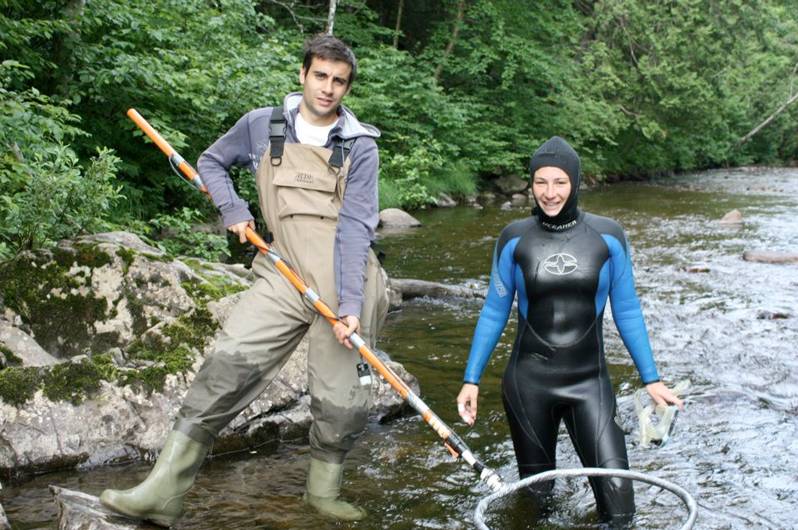
Chloe Bernard-Florat and Nicholas Clavel carrying
out field
survey for PIT vs snorkeling study. Photo credit: C. Bernard-Florat 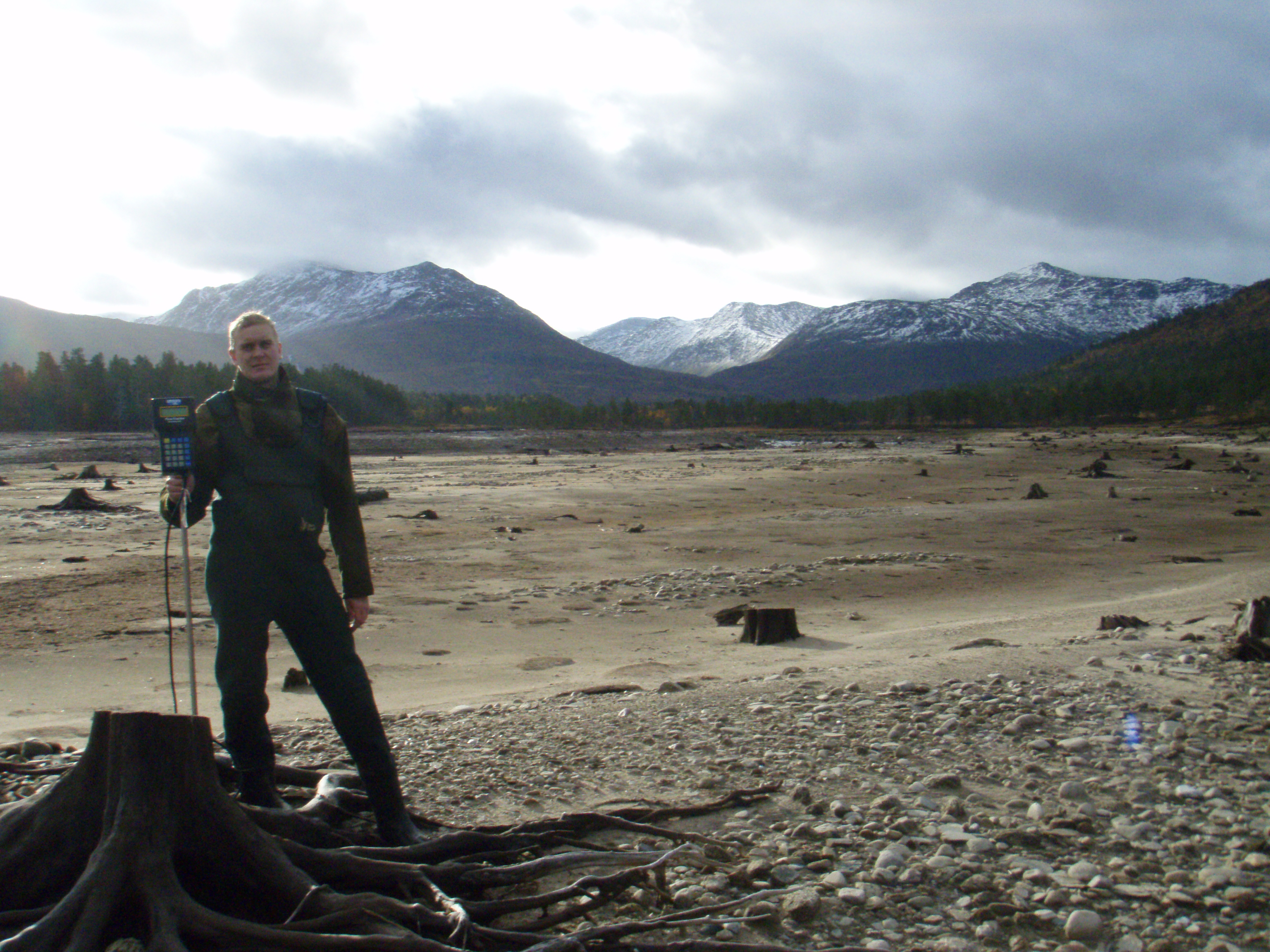

River Daleelva in western Norway
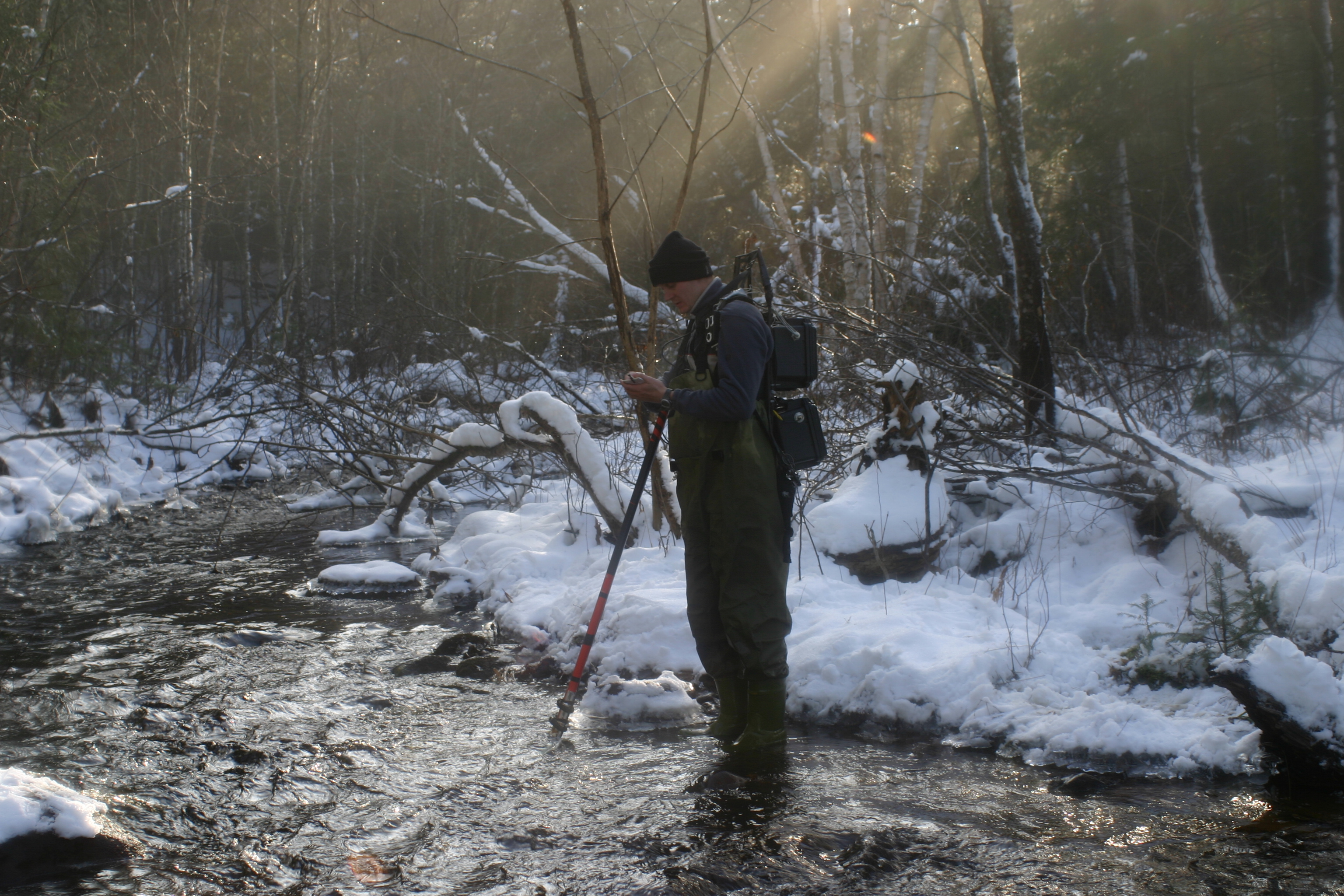
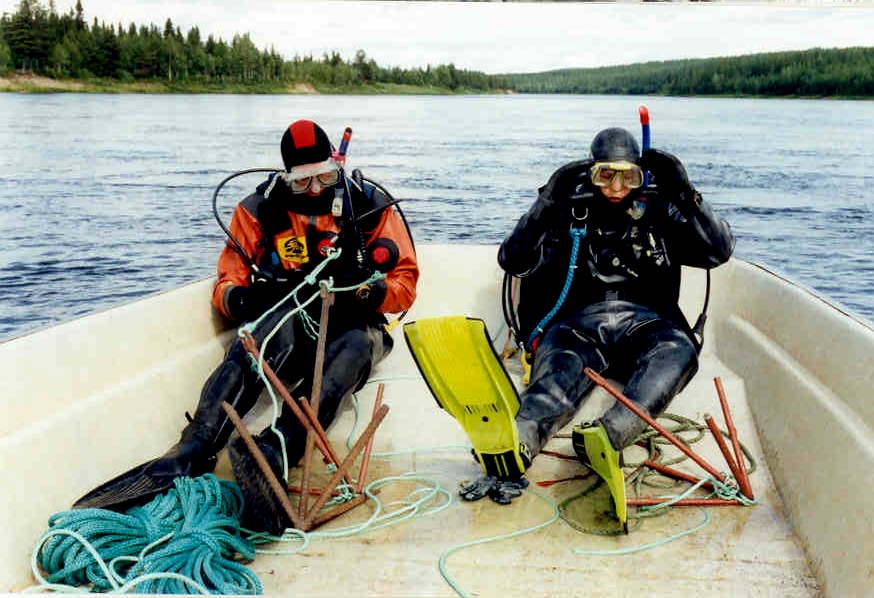
with Dr. P. Louhi. Photo credit: Mr. S. Vatanen. 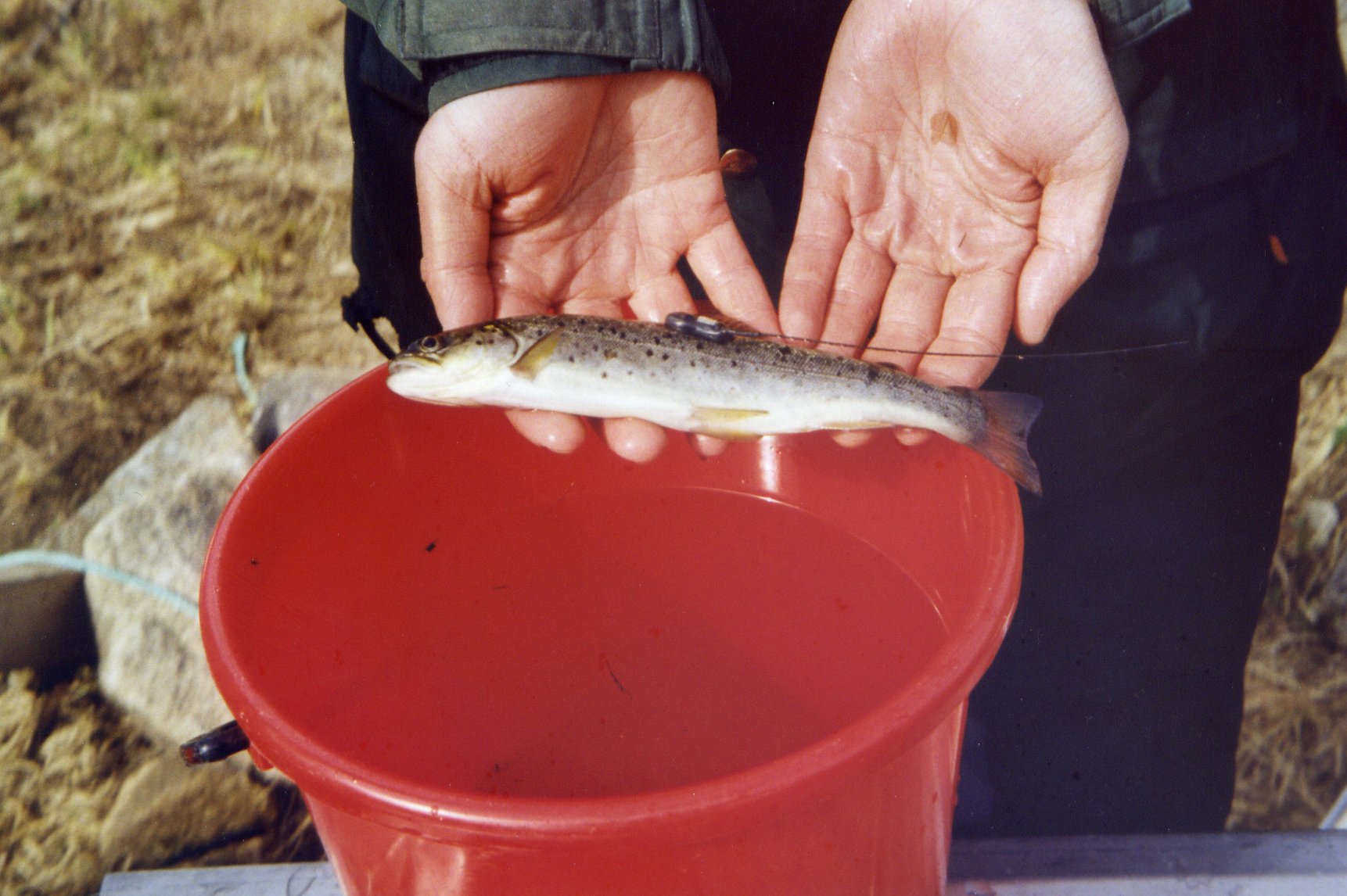
Radiotagged anadromous brown trout smolt ready
to continue
migration towards the Baltic sea. 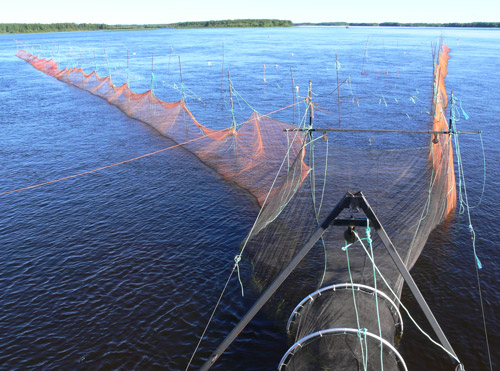
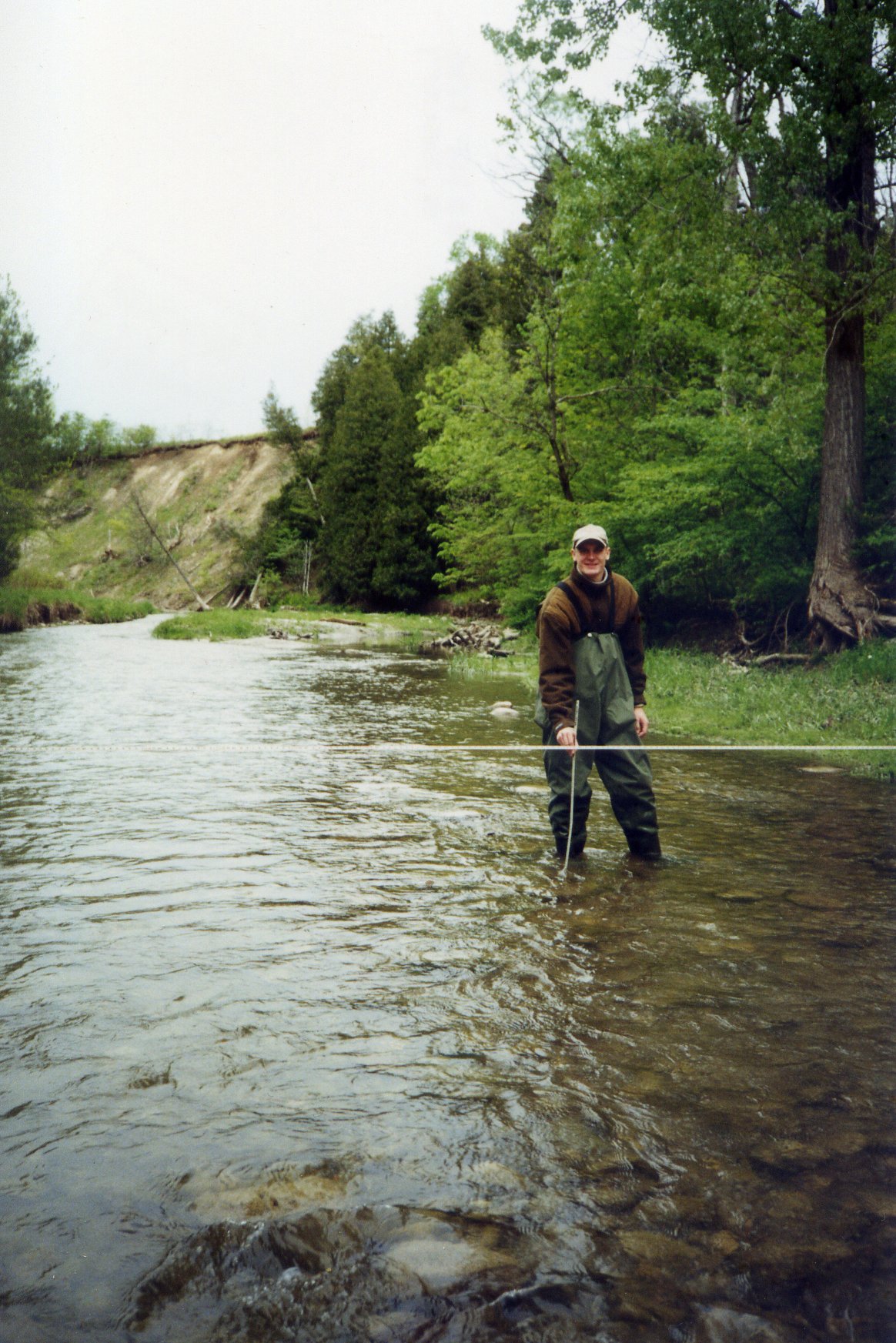
Working on a transect
in a small southern Ontario stream.
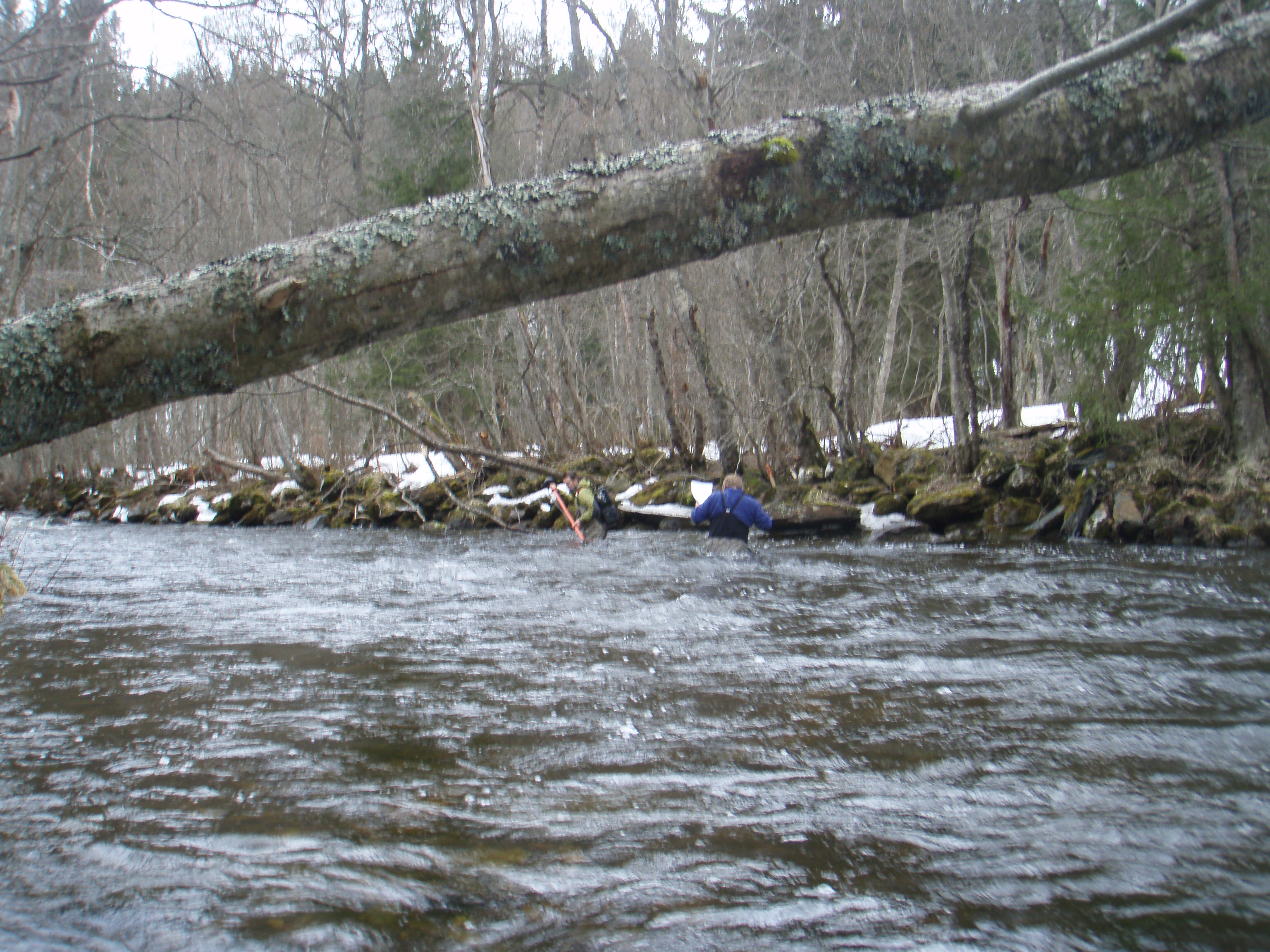
Dr. M. Stickler and Prof. O.K. Berg tracking PIT-tagged juvenile Atlantic salmon and brown trout during a snow-melt flood event in the River Sokna (a tributary to the River Gaula) in central Norway. 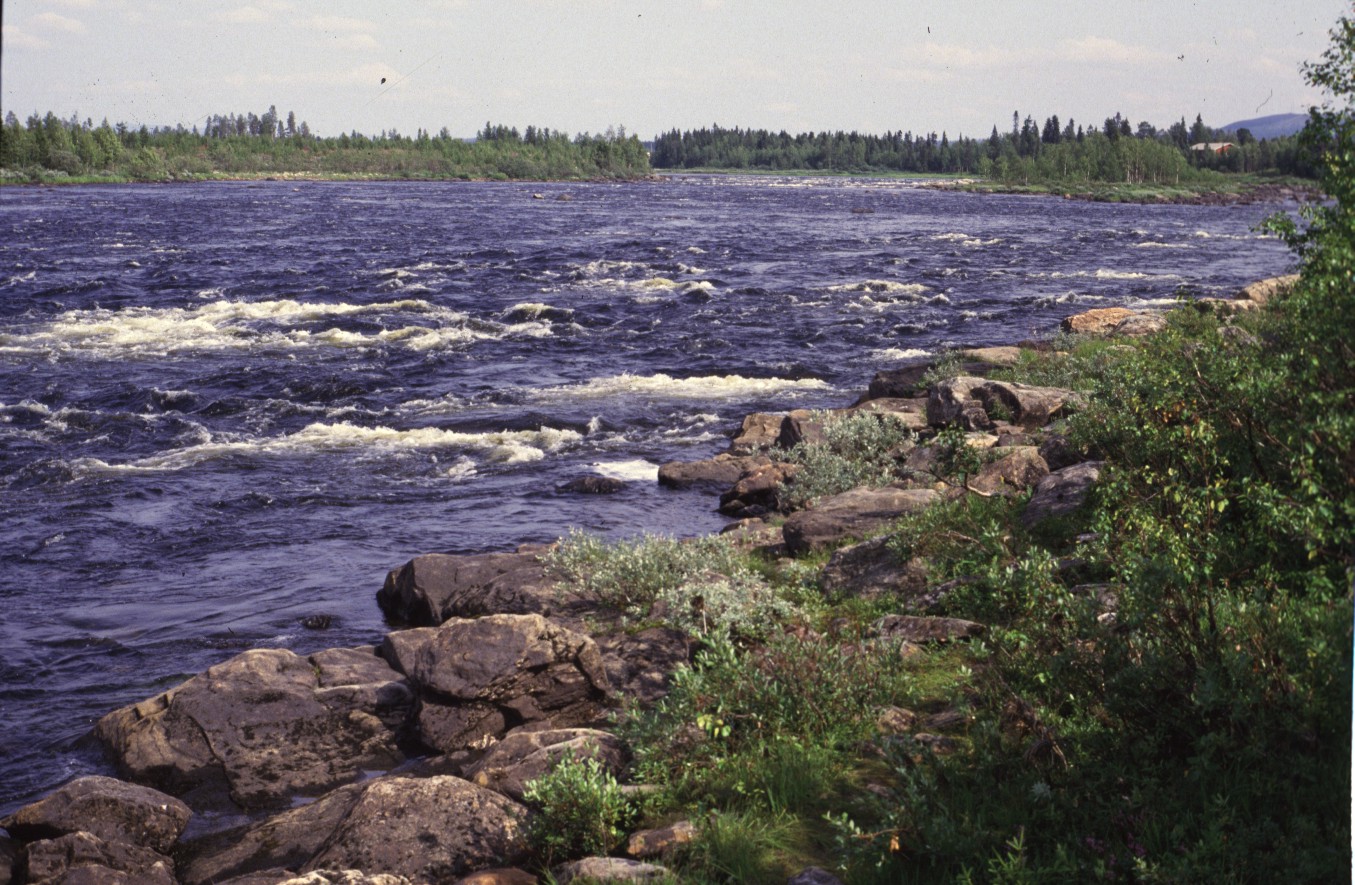
Saarikoski rapids located in the River Muonionjoki (a large tributary to the River Tornionjoki) is one of the sites where salmon parr were sampled in an effort to establish a stable isotope signature map of the river system. Photo credit: A. Romakkaniemi |